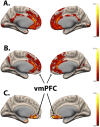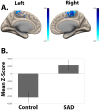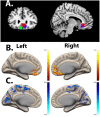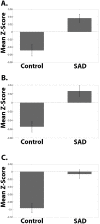Altered resting-state functional connectivity of the frontal-striatal reward system in social anxiety disorder
- PMID: 25928647
- PMCID: PMC4416052
- DOI: 10.1371/journal.pone.0125286
Altered resting-state functional connectivity of the frontal-striatal reward system in social anxiety disorder
Abstract
We investigated differences in the intrinsic functional brain organization (functional connectivity) of the human reward system between healthy control participants and patients with social anxiety disorder. Functional connectivity was measured in the resting-state via functional magnetic resonance imaging (fMRI). 53 patients with social anxiety disorder and 33 healthy control participants underwent a 6-minute resting-state fMRI scan. Functional connectivity of the reward system was analyzed by calculating whole-brain temporal correlations with a bilateral nucleus accumbens seed and a ventromedial prefrontal cortex seed. Patients with social anxiety disorder, relative to the control group, had (1) decreased functional connectivity between the nucleus accumbens seed and other regions associated with reward, including ventromedial prefrontal cortex; (2) decreased functional connectivity between the ventromedial prefrontal cortex seed and lateral prefrontal regions, including the anterior and dorsolateral prefrontal cortices; and (3) increased functional connectivity between both the nucleus accumbens seed and the ventromedial prefrontal cortex seed with more posterior brain regions, including anterior cingulate cortex. Social anxiety disorder appears to be associated with widespread differences in the functional connectivity of the reward system, including markedly decreased functional connectivity between reward regions and between reward regions and lateral prefrontal cortices, and markedly increased functional connectivity between reward regions and posterior brain regions.
Conflict of interest statement
Figures









Similar articles
-
Hyper-connectivity of subcortical resting-state networks in social anxiety disorder.Brain Connect. 2014 Mar;4(2):81-90. doi: 10.1089/brain.2013.0180. Epub 2014 Jan 30. Brain Connect. 2014. PMID: 24279709
-
Aberrant regional neural fluctuations and functional connectivity in generalized anxiety disorder revealed by resting-state functional magnetic resonance imaging.Neurosci Lett. 2016 Jun 15;624:78-84. doi: 10.1016/j.neulet.2016.05.005. Epub 2016 May 6. Neurosci Lett. 2016. PMID: 27163197
-
Specifically altered brain responses to threat in generalized anxiety disorder relative to social anxiety disorder and panic disorder.Neuroimage Clin. 2016 Oct 5;12:698-706. doi: 10.1016/j.nicl.2016.09.023. eCollection 2016. Neuroimage Clin. 2016. PMID: 27761400 Free PMC article.
-
Task MRI-Based Functional Brain Network of Anxiety.Adv Exp Med Biol. 2020;1191:3-20. doi: 10.1007/978-981-32-9705-0_1. Adv Exp Med Biol. 2020. PMID: 32002919 Review.
-
Abnormal functional connectivity in resting state contributes to the weaker emotional sensitivity to reward in depression.J Clin Exp Neuropsychol. 2022 Nov;44(9):640-650. doi: 10.1080/13803395.2022.2156480. Epub 2022 Dec 22. J Clin Exp Neuropsychol. 2022. PMID: 36548202 Review.
Cited by
-
Imaging the socially-anxious brain: recent advances and future prospects.F1000Res. 2020 Apr 2;9:F1000 Faculty Rev-230. doi: 10.12688/f1000research.21214.1. eCollection 2020. F1000Res. 2020. PMID: 32269760 Free PMC article. Review.
-
Associations between resting-state neural connectivity and positive affect in social anxiety disorder.Brain Behav. 2023 Jun;13(6):e3006. doi: 10.1002/brb3.3006. Epub 2023 Apr 16. Brain Behav. 2023. PMID: 37062915 Free PMC article.
-
Intrinsic functional connectivity in families genetically enriched for social anxiety disorder - an endophenotype study.EBioMedicine. 2021 Jul;69:103445. doi: 10.1016/j.ebiom.2021.103445. Epub 2021 Jun 20. EBioMedicine. 2021. PMID: 34161885 Free PMC article.
-
Reconnecting in the Face of Exclusion: Individuals with High Social Anxiety May Feel the Push of Social Pain, but not the Pull of Social Rewards.Cognit Ther Res. 2022;46(2):420-435. doi: 10.1007/s10608-021-10263-z. Epub 2021 Aug 17. Cognit Ther Res. 2022. PMID: 34421156 Free PMC article.
-
Low intensity repetitive transcranial magnetic stimulation modulates brain-wide functional connectivity to promote anti-correlated c-Fos expression.Sci Rep. 2022 Nov 29;12(1):20571. doi: 10.1038/s41598-022-24934-8. Sci Rep. 2022. PMID: 36446821 Free PMC article.
References
-
- Kessler R, Berglund P, Demier O, Jin R, Merikangas K, Walters E. Lifetime prevalence and age-of-onset distributions of DSM-IV disorders in the National Comorbidity Survey Replications. Arc of Gen Psychiatry. 2005; 62: 593–602. - PubMed
-
- Knutson B, Fong G, Adams C, Verner J, Hommer D. Dissociation of reward anticipation and outcome with event-related fMRI. Neuroreport. 2001; 12: 3683–3687. - PubMed
Publication types
MeSH terms
Grants and funding
LinkOut - more resources
Full Text Sources
Other Literature Sources
Medical

